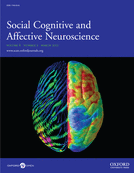Social Cognitive and Affective Neuroscience
Social Cognitive and Affective Neuroscience (SCAN) is an interdisciplinary field that integrates aspects of psychology, neuroscience, and cognitive science to understand how cognitive and emotional processes interact to influence behavior. This field specifically examines the neural mechanisms underlying social cognition, which involves how we perceive, think about, and interact with others, as well as affective processes, which relate to feelings and emotions.
Overview[edit | edit source]
Social Cognitive and Affective Neuroscience explores the complex interplay between the brain, mind, and social behavior. It employs a variety of neuroimaging and neurophysiological techniques, such as functional magnetic resonance imaging (fMRI), electroencephalography (EEG), and transcranial magnetic stimulation (TMS), to investigate the neural bases of social and emotional processes. These include empathy, moral judgment, social decision-making, and the experience and regulation of emotions.
Key Concepts[edit | edit source]
Social Cognition[edit | edit source]
Social cognition involves how individuals process, store, and apply information about other people and social situations. It includes understanding others' beliefs, intentions, and emotions, which is crucial for navigating complex social worlds. SCAN research in this area often focuses on regions of the brain such as the medial prefrontal cortex (mPFC), temporoparietal junction (TPJ), and amygdala, which are critical for theory of mind, empathy, and emotion recognition.
Affective Neuroscience[edit | edit source]
Affective neuroscience is the study of the neural mechanisms of emotion. This includes how emotions are generated and regulated within the brain, as well as how they influence cognition and behavior. Key brain regions involved in affective processes include the amygdala, orbitofrontal cortex (OFC), and ventromedial prefrontal cortex (vmPFC). SCAN research in this area seeks to understand how emotional responses are shaped by social contexts and how they impact social interactions.
Neuroeconomics[edit | edit source]
Neuroeconomics is a subfield of SCAN that examines how brain activity influences economic decision-making, particularly in social contexts. This includes understanding how people make choices about trust, altruism, and fairness. Studies often focus on the role of the striatum, prefrontal cortex, and amygdala in reward processing and decision-making under uncertainty.
Applications[edit | edit source]
The insights gained from Social Cognitive and Affective Neuroscience have broad applications, including improving mental health treatments, enhancing educational strategies, and informing public policy. For example, understanding the neural basis of empathy and social cognition can lead to better interventions for autism spectrum disorder (ASD) and social anxiety disorder. Additionally, insights into emotional regulation can inform treatments for depression and post-traumatic stress disorder (PTSD).
Challenges and Future Directions[edit | edit source]
One of the main challenges in SCAN is the complexity of social behavior and the difficulty of simulating realistic social interactions in a laboratory setting. Future research aims to employ more naturalistic experimental designs and advanced computational models to better understand the dynamic nature of social and emotional processes. Additionally, there is a growing emphasis on cross-cultural studies to explore how social and affective neural mechanisms vary across different cultural contexts.
| Social Cognitive and Affective Neuroscience Resources | ||
|---|---|---|
|
| |
Navigation: Wellness - Encyclopedia - Health topics - Disease Index - Drugs - World Directory - Gray's Anatomy - Keto diet - Recipes
Search WikiMD
Ad.Tired of being Overweight? Try W8MD's physician weight loss program.
Semaglutide (Ozempic / Wegovy and Tirzepatide (Mounjaro / Zepbound) available.
Advertise on WikiMD
WikiMD is not a substitute for professional medical advice. See full disclaimer.
Credits:Most images are courtesy of Wikimedia commons, and templates Wikipedia, licensed under CC BY SA or similar.Contributors: Prab R. Tumpati, MD


